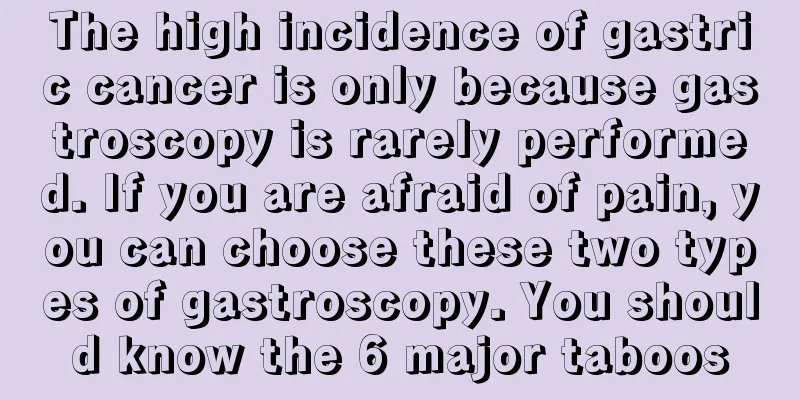The high incidence of gastric cancer is only because gastroscopy is rarely performed. If you are afraid of pain, you can choose these two types of gastroscopy. You should know the 6 major taboos

|
Tumors are not absolutely fatal diseases. As long as they are detected in the early stage and receive standardized treatment, patients still have a chance of recovery or continued survival. Gastric cancer is one of the most common tumor diseases in my country. Its risk factors are related to lifestyle habits, dietary structure, family inheritance, Helicobacter pylori infection, and the development of certain chronic gastric diseases. In clinical diagnosis, many patients are in the middle and late stages when their condition is confirmed, missing the best treatment period. The main reason is that they did not detect the disease in time. The common problem is that they did not undergo gastroscopy when lesions were found in the stomach. Gastroscopy is the main means of screening for gastric tumors and digestive tract tumors. The early symptoms of gastric tumors are relatively hidden, and there may not even be obvious abnormalities, which leads to patients neglecting diagnosis and treatment. It is also possible that the patient is afraid of the pain of gastroscopy and thinks that the condition is not serious, so he did not do the examination. These procrastination behaviors provide convenient conditions for the development of gastric tumors. Here we recommend that everyone pay attention to stomach health. Once abnormalities are found, it is safer to do a gastroscopy. If you are afraid of pain, you can choose 2 types of painless gastroscopy. Contraindications of painless gastroscopy: The examination scope and applicable groups of this painless gastroscopy are the same as those of ordinary gastroscopy, but there are 6 contraindications that must be noted: 4. If there is bleeding, vomiting blood, fluid retention, etc. in the digestive system, painless gastroscopy cannot be performed directly. Gastric decompression and other treatments are required. After eliminating the retained fluid and stopping the bleeding, it is determined whether painless gastroscopy can be performed based on the patient's condition. The second type: comfortable gastroscopy <br/>Since it is called comfortable gastroscopy, the experience of this examination is more or less better than painless gastroscopy. This is indeed the case. Comfortable gastroscopy has little irritation to the throat. It enters the stomach through the nasal cavity, and the catheter is thinner, so it is basically painless. In addition, comfortable gastroscopy can avoid nausea and vomiting caused by the catheter entering the throat. The catheter itself is about 5 mm long, and some doctors can perform stomach examinations on themselves alone. |
>>: Will stomach cancer metastasize? Yes, it will metastasize
Recommend
What is a hermaphrodite
In life, many people don't know enough about ...
Smoking is the main cause of lung cancer
The causes of lung cancer are complex, but the mo...
Is the vision rehabilitation eye mask useful?
There are really many people with myopia nowadays...
There are bloodshot on the ankles_There are red bloodshot on the ankles
The ankle is an area that may be noticed by every...
Risk factors of osteosarcoma
What are the dangers of osteosarcoma? This is a q...
What is the most common cause of lung cancer? Five high-risk factors for lung cancer
Lung cancer is a disease with a very poor prognos...
What's going on with my heart beating faster and breathing becoming difficult?
For friends who have rapid heartbeat and difficul...
How big is the fetus at 56 days of pregnancy?
On the 56th day of pregnancy, it is still in the ...
What are the storage methods for dried fruits
Dried fruits are rich in many nutrients. Eating m...
How to train your butt to get the best effect
Adolescent women tend to like tall, white and sle...
Where can I remove moisture by fumigating with moxa sticks
Moxibustion is a health-preserving method in trad...
What kind of yogurt should I use to make juice?
It is well known that fruit has many benefits for...
Wrong anal lifting method?
In daily life, women who give birth naturally wil...
What medicine works quickly for migraine?
Migraine is a very common primary headache in lif...
Is it good to urinate quickly after drinking beer and what should you pay attention to?
Maybe many of us love drinking beer and have the ...









